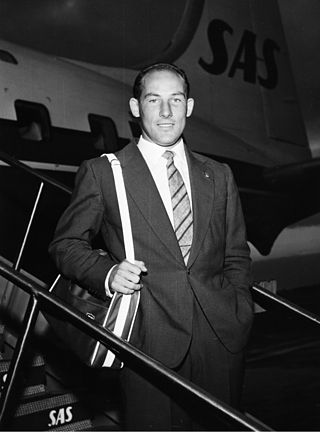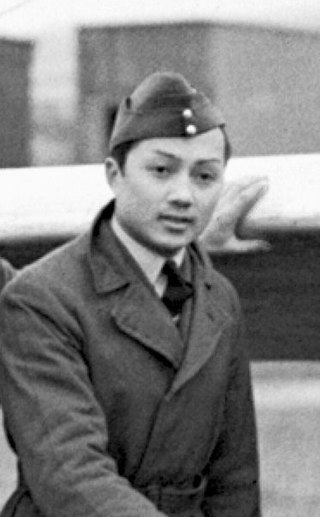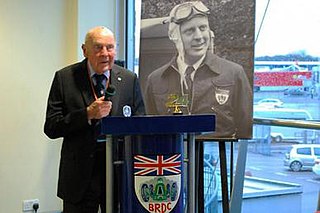
Alberto Ascari was an Italian racing driver, who competed in Formula One from 1950 to 1955. Ascari won two Formula One World Drivers' Championship titles, which he won in 1952 and 1953 with Ferrari, and won 13 Grands Prix across six seasons. In endurance racing, Ascari won the Mille Miglia in 1954 with Lancia.

Sir Stirling Craufurd Moss was a British racing driver and broadcaster, who competed in Formula One from 1951 to 1961. Widely regarded as one of the greatest drivers to never win the Formula One World Drivers' Championship, Moss won a record 212 official races across several motorsport disciplines, including 16 Formula One Grands Prix. In endurance racing, Moss won the 12 Hours of Sebring in 1954, as well as the Mille Miglia in 1955 with Mercedes.

The British Grand Prix is a Grand Prix motor racing event organised in the United Kingdom by Motorsport UK. First held by the Royal Automobile Club (RAC) in 1926, the British Grand Prix has been held annually since 1948 and has been a round of the FIA Formula One World Championship every year since 1950. In 1952, following the transfer of the lease of the Silverstone Circuit to the British Racing Drivers' Club, the RAC delegated the organisation of races held at Silverstone to the BRDC, and those held at Aintree to the British Automobile Racing Club. This arrangement lasted until the RAC created the Motor Sports Association in the late 1970s and it reclaimed organising control of the event. The RAC MSA was renamed Motorsport UK in 2019 when it formally split from the RAC.
Grand Prix motor racing, a form of motorsport competition, has its roots in organised automobile racing that began in France as early as 1894. It quickly evolved from simple road races from one town to the next, to endurance tests for car and driver. Innovation and the drive of competition soon saw speeds exceeding 100 miles per hour (160 km/h), but because early races took place on open roads, accidents occurred frequently, resulting in deaths both of drivers and of spectators. A common abbreviation used for Grand Prix racing is "GP" or "GP racing".

Midget cars, also Speedcars in Australia, is a class of racing cars. The cars are very small with a very high power-to-weight ratio and typically use four cylinder engines. They originated in the United States in the 1930s and are raced on most continents. There is a worldwide tour and national midget tours in the United States, Australia, Argentina and New Zealand.

José Froilán González was an Argentine racing driver, who competed in Formula One between 1950 and 1960. Nicknamed "The Pampas Bull", González was runner-up in the Formula One World Drivers' Championship in 1954 with Ferrari, and won two Grands Prix across nine seasons. In endurance racing, González won the 24 Hours of Le Mans in 1954, also with Ferrari.

The 1950 British Grand Prix, formally known as The Royal Automobile Club Grand Prix d'Europe Incorporating The British Grand Prix, was a Formula One motor race held on 13 May 1950 at the Silverstone Circuit in Silverstone, England. It was the first World Championship Formula One race, as well as the fifth British Grand Prix, and the third to be held at Silverstone after motor racing resumed after World War II. It was the first race of seven in the 1950 World Championship of Drivers.

Peter Nield Whitehead was a British racing driver. He was born in Menston, Yorkshire and was killed in an accident at Lasalle, France, during the Tour de France endurance race. A cultured, knowledgeable and well-travelled racer, he was excellent in sports cars. He won the 1938 Australian Grand Prix, which along with a 24 Heures du Mans win in 1951, probably was his finest achievement, but he also won two 12 Heures internationales de Reims events. He was a regular entrant, mostly for Peter Walker and Graham Whitehead, his half-brother. His death in 1958 ended a career that started in 1935 – however, he was lucky to survive an air crash in 1948.

Reginald Parnell was a racing driver and team manager from Derby, England. He participated in seven Formula One World Championship Grands Prix, achieving one podium, and scoring a total of nine championship points.

Philippe Jean Armand Étancelin was a French racing driver, and a winner of the 1934 24 Hours of Le Mans. He competed primarily on the Grand Prix circuit, and was an early Formula One driver.

Prince Birabongse Bhanudej Bhanubandh, commonly known as Prince Bira of Siam or simply Prince Bira, was a member of the Thai royal family. Bira was also a racing driver, sailor and pilot, who competed in Formula One from 1950 to 1954 and at four editions of the Summer Olympics between 1956 and 1972.

Eric David Thompson was a British racing driver, book dealer and insurance broker. He participated in sports car racing between 1949 and 1955 taking his greatest success by finishing third in the 1951 Les 24 Heures du Mans and took part in the 1952 RAC British Grand Prix.

Formula Libre, also known as Formule Libre, is a form of automobile racing allowing a wide variety of types, ages and makes of purpose-built racing cars to compete "head to head". This can make for some interesting matchups, and provides the opportunity for some compelling driving performances against superior machinery. The name translates to "Free Formula" – in Formula Libre races the only regulations typically govern basics such as safety equipment.

The Pau Grand Prix is a motor race held in Pau, in the Pyrénées-Atlantiques department of southwestern France. The French Grand Prix was held at Pau in 1930, leading to the annual Pau Grand Prix being inaugurated in 1933. It was not run during World War II and in 2020–2021 due to the COVID-19 pandemic.
Formula Pacific was a motor racing category which was used in the Pacific Basin area from 1977 to 1982. It specified a single-seat, open-wheeler chassis powered by a production-based four-cylinder engine of under 1600cc capacity. The formula was based on Formula Atlantic, with provision made for the use of Japanese engines. The category was superseded in 1983 by Formula Mondial, which was devised by the FIA to replace both Formula Atlantic and Formula Pacific.

The Buenos Aires Grand Prix is a motor race held in Buenos Aires, Argentina.

The New Zealand Grand Prix, sometimes known as the New Zealand International Grand Prix, is an annual motor racing event held in New Zealand. First held in 1950, it is best known for hosting rounds of the Tasman Series in the 1960s and 1970s. It is currently run as the signature race of the Formula Regional Oceania Championship.

The 1955 New Zealand Grand Prix was a motor race held at the Ardmore Circuit on 8 January 1955. It was the third iteration of the New Zealand Grand Prix and was run to Formula Libre regulations.

The 1954 New Zealand Grand Prix was a motor race held at the Ardmore Circuit on 9 January 1954. This was the first New Zealand Grand Prix since 1950 and the second overall. This was also the first New Zealand Grand Prix to be held at the Ardmore Circuit, a venue that would be used for the Grand Prix until 1962.
Motorsport New Zealand is the national governing and sanctioning body for four-wheeled motorsport in New Zealand. It is affiliated with the Federation Internationale de l'Automobile (FIA).
















